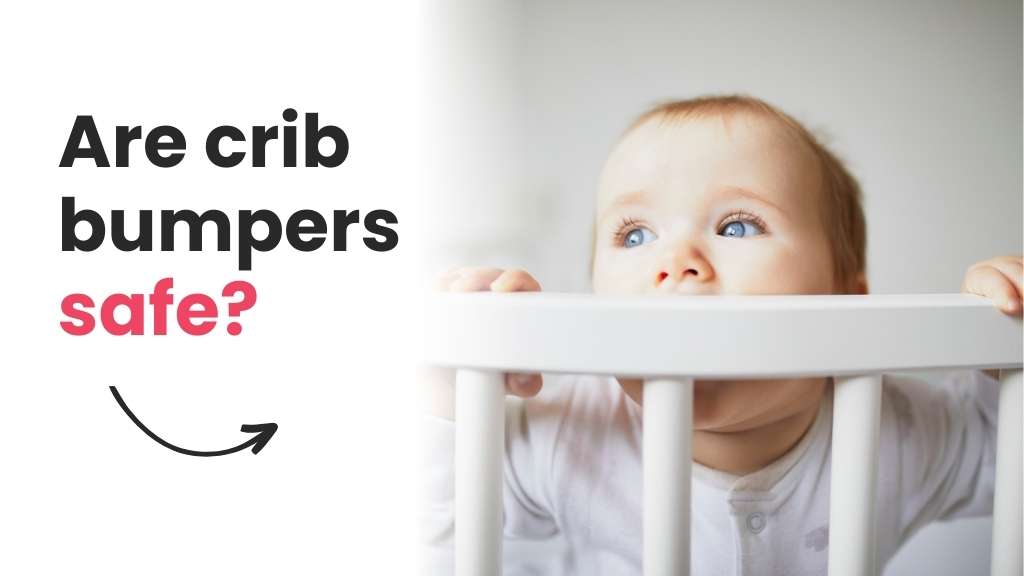
Table of Contents
Introduction
Crib bumpers have been a common addition to baby cribs for decades. They are typically used to prevent a baby from getting their arms and legs stuck between the crib slats or to protect them from bumping their heads against the hard crib sides. However, in recent years, concerns about the safety of crib bumpers have arisen. This blog post will explore the controversy surrounding crib bumpers and discuss whether are crib bumpers safe for babies
The History of Crib Bumpers
Crib bumpers were originally designed to provide additional safety for infants. They were created to address the risk of a baby’s head or limbs becoming trapped between the crib slats. However, over time, the design and use of crib bumpers have evolved, and so have the concerns surrounding their safety.
Safety Concerns: Are Crib Bumpers Safe?
- Risk of Suffocation: One of the primary concerns with crib bumpers is the risk of suffocation. If a baby’s face becomes pressed against a crib bumper, it could obstruct their airway, leading to suffocation. This risk is especially high for very young infants who may lack the motor skills to reposition themselves.
- Overheating: Crib bumpers can also contribute to overheating in a crib. When a crib is filled with soft bedding, including bumpers, blankets, and pillows, it can trap heat and increase the risk of sudden infant death syndrome (SIDS).
- Climbability: As babies grow and become more mobile, they may use crib bumpers as a step to climb out of the crib. This poses a risk of falling and injury.
- SIDS Risk: Some studies have suggested a potential link between the use of crib bumpers and an increased risk of SIDS. While the evidence is not conclusive, it has raised concerns among pediatric experts.
Safety Guidelines
To address these safety concerns, various health and safety organizations have issued guidelines regarding crib bumpers:
1. American Academy of Pediatrics (AAP): The AAP advises against the use of crib bumpers, citing the risks of suffocation, strangulation, and SIDS. They recommend using a firm crib mattress with a fitted sheet and nothing else in the crib
2. Consumer Product Safety Commission (CPSC): The CPSC has investigated crib bumper-related incidents and issued warnings about their use. They recommend avoiding the use of crib bumpers, especially padded ones.
3. Individual State Laws: Some U.S. states have banned the sale of crib bumpers, while others have imposed strict regulations on their design and use.
Alternatives to Crib Bumpers
Instead of using crib bumpers, parents can consider safer alternatives to ensure their baby’s crib is a safe sleep environment:
- Use a firm mattress: A firm crib mattress with a fitted sheet is recommended for safe sleep.
- Avoid soft bedding: Remove pillows, quilts, and stuffed animals from the crib.
- Maintain a comfortable room temperature: Dress your baby in appropriate clothing to keep them warm without the need for additional bedding.
- Fitted crib sheet only: Cover the mattress with a fitted crib sheet that fits securely around the corners. Avoid using loose bedding, such as blankets, quilts, or pillows.
- Bare is best: Keep the crib free of any soft or loose items. This includes stuffed animals, bumper pads, and blankets. These can pose suffocation hazards. Instead, dress your baby in a sleep sack or wearable blanket for warmth.
- Position the baby on their back: Always place your baby to sleep on their back for every sleep, whether it’s a nap or nighttime sleep. This position is the safest to reduce the risk of SIDS.
- Use a pacifier for sleep: If your baby takes a pacifier, consider offering it at naptime and bedtime. Some studies suggest that pacifier use during sleep can reduce the risk of SIDS.
- Breastfeeding: If possible, consider breastfeeding your baby. Breastfeeding is associated with a lower risk of SIDS.
- Share your room, not your bed: The American Academy of Pediatrics (AAP) recommends room-sharing with the little one but not bed-sharing. Place your baby’s crib or bassinet in your room for the first six months to a year of their life.
- Check for hazardous items: Regularly inspect the crib for any hazards such as loose screws, sharp edges, or peeling paint. Ensure the crib’s slats are no more than 2 3/8 inches apart to prevent your baby from getting stuck.
- No smoking: Do not allow smoking in your home or near your baby. Exposure to secondhand smoke increases the risk of SIDS.
- Regular check-ins: During naptime and nighttime sleep, periodically check on your baby to ensure they are sleeping safely and comfortably.
- Educate caregivers: Make sure anyone who cares for your baby (babysitters, relatives, daycare providers) is aware of and follows safe sleep practices.
By following these guidelines for a safe sleeping environment, you can significantly reduce the risk of SIDS and ensure that your baby sleeps comfortably and securely. Always consult with your pediatrician or healthcare provider for personalized advice and guidance on safe sleep practices for your baby
Conclusion: Are Crib Bumpers Safe?
The safety of crib bumpers remains a topic of debate and concern. While they were originally intended to enhance infant safety, the risks associated with crib bumpers, including suffocation and SIDS, have led many health organizations to recommend against their use. Parents and caregivers must prioritize safe sleep environments for infants, following guidelines from trusted sources such as the AAP and CPSC. Ultimately, the decision regarding crib bumpers should prioritize the safety and well-being of the baby above all else.









